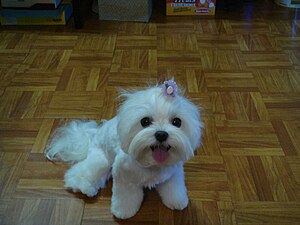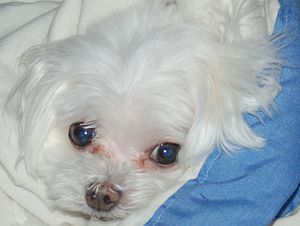This is an old revision of this page, as edited by 67.173.104.111 (talk) at 11:17, 24 January 2009 (→Description). The present address (URL) is a permanent link to this revision, which may differ significantly from the current revision.
Revision as of 11:17, 24 January 2009 by 67.173.104.111 (talk) (→Description)(diff) ← Previous revision | Latest revision (diff) | Newer revision → (diff) Dog breed| Maltese | |||||||||
|---|---|---|---|---|---|---|---|---|---|
 A Maltese with a "Puppy Cut" A Maltese with a "Puppy Cut" | |||||||||
| Other names | Bichon Maltaise, Isle of malta dog | ||||||||
| Origin | Island of Malta | ||||||||
| |||||||||
| Dog (domestic dog) | |||||||||
A Maltese is a small breed of dog in the toy group. The Maltese does not shed and is covered with long, silky white fur. The Maltese breed of today is descended from dogs long associated with the island of Malta. It is one of the oldest dog breeds.
Description
Appearance

Characteristics include slightly rounded skulls, with a one-finger-wide dome and a black nose that is two finger widths long. The body is compact with the length equaling the height. The drop ears with long hair and very dark eyes, surrounded by darker skin pigmentation (called a "halo"), gives Maltese their expressive look. Their noses can fade and become pink or light brown in color without exposure to sun light. This is often referred to as a "winter nose" and many times will become black again with increased exposure to the sun.
Coat and color
The coat is long and silky and lacks an undercoat. The color is pure white and although cream or light lemon ears are permissible, they are not desirable.
Size

Adult Maltese range from roughly 3 to 7 lb (1.4 to 3.0 kg), though breed standards, as a whole, call for weights between 4 and 7 lb (1.8 to 3. kg). There are variations depending on which standard is being used; many, like the American Kennel Club, call for a weight that is ideally less than 7 lb with between 4 and 6 lb preferred.
Temperament

For all their diminutive size, Maltese seem to be without fear. In fact, many Maltese seem indifferent to creatures and objects larger than themselves but can also be quite aggressive for their small size, which makes them very easy to socialize with other dogs, and even cats. They love time with owners. This is because they were bred to be companion dogs and thrive on love and attention. They are extremely lively and playful, and even as a Maltese ages, his or her energy level and playful demeanor remains fairly constant and does not diminish much.
Maltese are very good with children and infants. Maltese do not require much physical exercise, although they should be walked daily to reduce problem behavior. They enjoy running and are more inclined to play games of chase, rather than play with toys. Some Maltese can occasionally be snappy with smaller children and should be supervised when playing, although socializing them at a young age will reduce this habit. The Maltese is very active within a house, and, preferring enclosed spaces, does very well with small yards. For this reason the breed also does well with apartments and townhouses, and is a prized pet of urban dwellers.
History
As an aristocrat of the canine world, this ancient breed has been known by a variety of names throughout the centuries. Originally called the "Melitaie Dog" he has also been known as "Ye Ancient Dogge of Malta", the "Roman Ladies' Dog," the "Majestic Creature", the "Comforter Dog," the "Spaniel Gentle," the "Bichon," the "Shock Dog," the "Maltese Lion Dog" and the "Maltese Terrier." Sometime within the past century, he has come to simply be known as the "Maltese." The breed's history can be traced back many centuries. Some have placed its origin at two or three thousand years ago and Darwin placed the origin of the breed at 6000 BC.
The Maltese is thought to have been descended from a Spitz type dog found among the Swiss Lake dwellers and bred down to obtain its small size. Although there is also some evidence that the breed originated in Asia and is related to the Tibetan Terrier, the exact origin is unknown . Maltese are generally associated with the island of Malta in the Mediterranean Sea. The dogs probably made their way to Europe through the Middle East with the migration of nomadic tribes. Some writers believe these proto-Maltese were used for rodent control and pig herding. before the appearance of the breed gained paramount importance. The Isle of Malta (or Melitae as it was then known) was a geographic center of early trade, and explorers undoubtedly found ancestors of the tiny, white dogs left there as barter for necessities and supplies. The dogs were favored by the wealthy and royalty alike and were bred over time to specifically be a companion animal. In fact, the Maltese were so favored by the Roman emperors, they chose to breed them to be pure white - something they considered a 'sacred color'. Before then, there were other light colors that Maltese come in - still seen again at the puppy stage, normally.
During the first century, Publius, the Roman governor of Malta, had a Maltese named Issa (Issa translates as "Now" in the Maltese language) of which he was very fond. The poet Marcus Valerius Martialis (Martial), born in 38 at Bilbilis in Spain, made this attachment famous in one of his celebrated epigrams:
- "Issa is more frolicsome than Catulla's sparrow."
- "Issa is purer than a dove's kiss."
- "Issa is gentler than a maiden."
- "Issa is more precious than Indian gems..."
- "Lest the last days that she sees light"
- "should snatch her from him forever,"
- "Publius has had her picture painted."
It is said that the painting of the dog was so life-like that one could not tell the dog from the picture.
During the Renaissance, the poet Ludovico Ariosto in a few lines of his literary masterpiece, "Orlando Furioso," describes a dog, that could possibly be a Maltese.
- "The tiniest dog Nature has ever produced --"
- "Her coat of long hair, whiter than ermine,"
- "Her movements exquisitely graceful and"
- "Matchless elegance of appearance."
- (Vol.II Canto 43)
Care

Maltese have no undercoat, and have little to no shedding if cared for properly. Like their relatives Poodles and Bichon Frisé, they are considered to be largely hypoallergenic and many people who are allergic to dogs may not be allergic to the Maltese (See list of Hypoallergenic dog breeds). They make very good friends with different breeds especially the lhasa apso. Daily cleaning is required to prevent the risk of tear-staining.
Regular grooming is also required, to prevent the coats of non-shedding dogs from matting. Many owners will keep their Maltese clipped in a "puppy cut," a 1 - 2" all over trim that makes the dog resemble a puppy. Some owners, especially those who show Maltese in the sport of conformation, prefer to wrap the long fur to keep it from matting and breaking off, and then to show the dog with the hair unwrapped combed out to its full length.
Dark staining in the hair around the eyes ("tear staining") can be a problem in this breed, and is mostly a function of how much the individual dog's eyes water and the size of the tear ducts. Tear stain can be readily removed if a fine-toothed metal comb, moistened with lukewarm water, is carefully drawn through the snout hair just below the eyes. This maintenance activity must be performed every two or three days, as a layer of sticky goo is quick to redevelop. If the face is kept dry and cleaned daily, the staining can be minimized. Many veterinarians recommend avoiding foods treated with food coloring and serving distilled water to reduce tear staining. Also, giving the dog bottled water may help.
Barking
Many toy breeds and small dogs are known to yap, scream or bite ankles. While Maltese dogs are not given to excessive barking, they will generally sound the alarm at noises in the night. In fact, legend has it that the ancient Romans would use the Maltese as alarm dogs, and raised them with Rottweilers, or a proto-Rottweiler breed. Intruders would first be confronted with the diminutive Maltese, only to be later confronted with their more formidable companions.
An isolated study in the Australian state of New South Wales found owners there likely to dump their Maltese terriers, citing their tendency to bark constantly. Such actions are condemned by animal protection agencies.
Crossbred Maltese dogs

A Crossbreed is a dog with two purebred parents of different breeds. Dogs traditionally were crossed in this manner in hopes of creating a puppy with desirable qualities from each parent. For pet dogs, crosses may be done to enhance the marketability of puppies, and are often given cute portmanteau names. Maltese are often deliberately crossed with Shih Tzus and Poodles to produce small, fluffy lap dogs. Maltese-Poodle crosses are called Maltepoos. Maltese crossed with Pugs are also seeing an increase in popularity. Maltese with Shih Tzus are called Mal-Shihs, Shihtese, or Mitzus. This results in a dog which is a small, friendly and intelligent animal with a unique low (or no) shedding coat.
Maltese crosses, like other crossbred dogs, are not eligible for registration by kennel clubs as they are not a breed of dog. Each kennel club has specific requirements for the registration of new breeds of dog, usually requiring careful record keeping for many generations, and the development of a breed club. At times, a crossbred dog will result in a new breed, as in the case in the 1950s when a Maltese and Lhasa Apso were accidentally bred. Descendants of that breeding are now a purebred breed of dog, the Kyi-Leo.
Maltese mixed-breed dogs
Mixed breed dogs are those of generally unknown ancestry, or complex ancestry. In the popular 1974 film Benji, the part of the dog Benji's heroic love interest, Tiffany, was played by a mixed breed female of primarily Maltese ancestry. She also appeared, with her mixed-breed puppies, in the film's 1977 sequel, For the Love of Benji.
See also
References
- Maltese Only FAQ
- Cutillo, Nicholas. 'The Complete Maltese'. Howell Book House, 1986. ISBN 0-87605-209-X
- Leitch, Virginia T., 1953; Carno, Dennis, 1970. The Maltese Dog - A History of the Breed, 2nd Ed.. International Institute of Veterinary Science
- Maltese Dog by Maltalaiset
- About the Maltese Breed - Maltese History and Origin
- Iveria, Miki, Maltese Dogs - The Jewels of Women. The Maltese Club of Great Britain, J. Riches & Co., Ltd., 1979. ISBN 0-9506129-0-1
- http://www.burkesbackyard.com.au/factsheets/Others/Dog-Dumpage/2960
- http://www.burkesbackyard.com.au/factsheets/Others/Dog-Dumpage/2960
External links
- Maltese dog history
- Clubs, Associations, Resources and Societies
- Maltese Dog Resource
- American Maltese Association
- Maltese Dog Club - UK
- Maltese Kennel Club of NSW - Australia
- Metropolitan Maltese Rescue - New York
- Northcentral Maltese Rescue, Inc.
- History of the Maltese
- Maltese Dog Lovers
- Maltese Mania in Thailand
- Maltese Dog Forums
- Find a beautiful healthy Maltese puppy in Canada